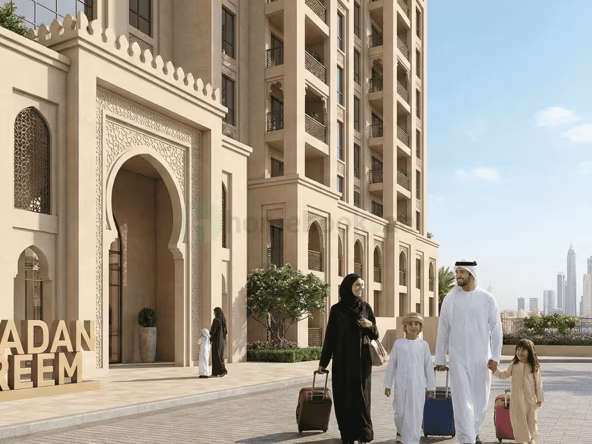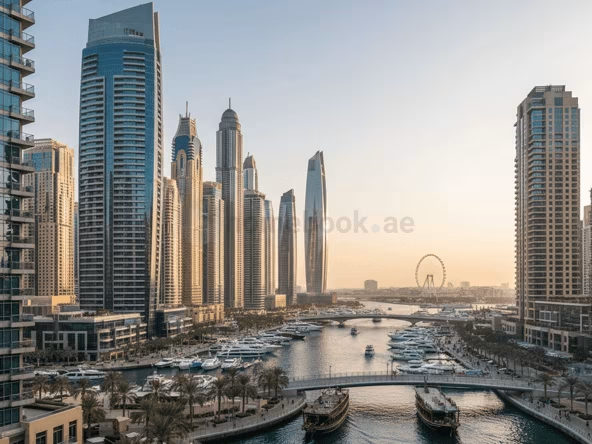Dubai’s shimmering skyline is a constant, but what happens behind those sleek towers changes with the seasons. The city’s rental market has its own unique rhythm—one that shifts with the weather, tourism trends, and broader economic forces. Whether you’re a hotel manager trying to optimize room rates, a landlord weighing the terms of a lease, or someone new to the city looking for a room rent in downtown Dubai near the iconic fountains, understanding this seasonal flow is essential. Here, we take a closer look at how these factors come together to shape rental prices in both the short- and long-term.
Why Seasons Matter in a Desert Metropolis
At first glance, it might seem like a desert city such as Dubai wouldn’t experience much seasonality—after all, temperatures rarely fall below 18°C, even in winter. But the contrast between a comfortable 27°C afternoon in January and the intense 45°C heat of July is dramatic, especially when it comes to visitor experience. These temperature shifts have a noticeable impact on tourism patterns, hotel occupancy rates, and tenant behavior.
- Comfort Season (October to April): This is when Dubai is at its most inviting, with cool mornings and pleasant evenings perfect for outdoor dining, beach outings, and sightseeing. The city comes alive with tourists and returning expats, sending demand for hotel rooms and short-term rentals soaring.
- Heat Season (May to September): As the mercury climbs, outdoor life slows to a crawl. From mid-June through August, even routine activities are kept to a minimum during daylight hours. Many residents escape to cooler destinations, and landlords often face the challenge of keeping properties occupied. For tenants with flexibility, this is the best time to negotiate lower rents.
This predictable swing in climate and demand sets the stage for nearly every other movement in Dubai’s rental market.
Impact on Hotels and Classic Short-Term Rentals
1. Seasonal Demand Fluctuations
Hotels in Dubai walk a fine line between keeping rooms full and maintaining profitable rates. During the cooler, high-season months, especially around Downtown and the Palm, five-star properties often raise their prices by 30% to 60%, knowing that many European tourists are happy to pay a premium for a sunny escape that feels like spring back home. But come mid-August, those same luxury rooms can drop dramatically in price—sometimes with added perks like free spa treatments—just to keep occupancy above 45%.
Behind the scenes, hotel revenue managers rely on sophisticated dynamic pricing tools that constantly adjust rates based on real-time bookings, competitor pricing, and even weather forecasts. A sudden cool breeze across the Gulf in late September, for instance, can cause room rates to jump overnight. On the flip side, something like a new visa restriction affecting a major tourist market can cause bookings—and prices—to dip, even during what would normally be a busy season.
2. Holiday Homes and the Inventory Squeeze
Online booking platforms and local property portals have flooded Dubai’s rental market with tens of thousands of holiday-home listings—ranging from single rooms in sleek Marina towers to sprawling villas in Emirates Hills. These short-term rentals give hosts the freedom to dramatically raise their nightly rates during peak times, like New Year’s Eve, when demand soars. As a result, many of these properties are temporarily pulled from the long-term rental pool.
This shift creates some clear ripple effects
Shrinking Long-Term Options: When a landlord can make in three weeks of winter what they’d earn in three months on a long-term lease, it’s no surprise many prefer short-term stays.
Market Fluctuations: After the peak season ends, some hosts quickly return their properties to the annual rental market, often all at once. This sudden influx drives down monthly rates temporarily until the market stabilizes.
For renters, especially those planning ahead, it’s not unusual to discover that a room rent in downtown Dubai during a two-week stretch in February could cost more than renting the same space for the entire month of August. Location convenience, paired with seasonal demand, ultimately dictates the price you’ll pay.
Climate Change and Shifting Tourism Patterns

Climate change is slowly pushing the Gulf’s already intense heat to new levels. Experts believe that by 2030, months like May and October—once considered mild—will start to feel more like the peak of summer. This means the cooler months that attract tourists and drive rental demand will become shorter, causing a surge of visitors within a tighter window. As a result, the competition for rental properties during winter could become even more intense.
At the same time, travel habits are changing. More people are looking for eco-friendly options, have flexible work schedules, or are choosing cooler destinations that are just starting to gain popularity. To keep tourists coming during the hotter months, Dubai is introducing more indoor attractions—like major concerts, sports tournaments, and shopping events inside air-conditioned malls. For renters, this shift brings two key trends:
- Rising Winter Competition: More travelers booking from November to February means higher prices, especially for prime spots like a room for rent in Dubai Marina with sea views.
- Creative Summer Deals: To keep units filled during the summer, landlords often get creative—offering perks like free utility bills, complimentary cleanings, or even a free week of rent in August to entice tenants willing to brave the heat.
Air Conditioning Costs and Seasonal Rental Adjustments
One of the biggest hidden costs of living in Dubai—especially during the summer—is air conditioning. As temperatures climb above 40°C, keeping your apartment cool becomes a necessity, not a luxury. But that comfort comes at a price. Electricity bills can easily double or even triple in the hotter months, especially in older buildings without energy-efficient cooling systems. Because of this, many renters start looking for “chiller-free” apartments, where the landlord covers the AC costs. These units are more popular in the summer and often rent out faster, even if the base rent is slightly higher.
Landlords, on the other hand, often adjust their rental strategies depending on the season. In the summer, when fewer people are moving in and AC costs are high, they may offer short-term discounts or include utility bills to attract tenants. Some even allow flexible lease terms or offer free rent for a week or two just to fill vacant units. By contrast, in the cooler months, demand rises and landlords can be more selective, raising rents and removing extras. Understanding these seasonal shifts in utility costs and rental pricing can help both tenants and landlords make smarter decisions.
Major Events and Their Shockwaves
Dubai’s calendar brims with headline-grabbing events:
| Event | Timing | Typical Rental Impact |
| Dubai Shopping Festival (DSF) | Jan–Feb | Hotel ADR and Marina studio rates jump 20 %–35 %. |
| Art Dubai & Design Week | March | Uptick in DIFC and Downtown loft bookings by creative professionals. |
| Ramadan & Eid Al-Fitr | Varies (Mar–Apr) | Family-sized villas surge, single studios soften. |
| Gitex Global Tech Show | October | Business Bay and World Trade Centre zones often sell out weeks prior. |
| New Year’s Eve Fireworks | 31 Dec | Downtown units with Burj Khalifa views hit record nightly tariffs. |
Renters scanning for a room for rent in Al Barsha might discover January bargains vanish once DSF banners drape every highway. Knowing the event cadence empowers both landlords and tenants to time contracts wisely.
Long-Term Residential Market: The Seasonality Within the Year
1. Spring Optimism, Autumn Lull
Rental and property sales data in Dubai clearly show that activity picks up noticeably between March and June. This period lines up with companies relocating staff after annual bonuses, and families looking to settle into new homes before the school holidays begin. The weather is also more pleasant during these months, making it a comfortable time for people to go out and view properties.
But once the intense summer heat kicks in, especially from July onward, things slow down. Many renters hold off on house-hunting, and real estate agents often schedule viewings in the evenings to avoid the daytime heat. As a result, demand dips and asking prices tend to drop slightly—particularly in mid-range areas like Jumeirah Village Circle (JVC) or older buildings along Sheikh Zayed Road. This seasonal slowdown is temporary, but it does give flexible renters a chance to negotiate better deals.
2. Micro-Markets React Differently
- Downtown Dubai: Dubai’s luxury rentals, mainly branded residences, stay in demand year-round, especially among international executives who want to live close to work. Still, lease renewals from June to August often drop 2–3% below winter rates, giving savvy renters a chance to negotiate better deals.
- Dubai Marina: Heavy exposure to holiday makers. A scenic room for rent in Dubai Marina can demand AED 6,000 a month from November through April but slide to AED 4,500 in July if the landlord refuses to include utilities.
- Al Barsha: Al Barsha’s steady demand from professionals like teachers and nurses keeps rents stable year-round. A furnished room for rent in Al Barsha usually stays between AED 3,000 and AED 3,300.
The Psychology of Consumer Preferences
Tenants rank factors such as price, safety, and investment value differently depending on the season:
- Winter Aspirations: With pleasant evenings and full tourist buzz, renters prioritize lifestyle—balcony brunches, Marina promenade jogging, quick access to beach clubs. They willingly stretch budgets for water views.
- Summer Practicality: Surging AC bills refocus attention on energy-efficient buildings, shaded parking, and chiller-free contracts. Al Barsha’s mid-rise blocks with district cooling maintain appeal over older Marina towers saddled with individual chillers.
Developers are responding to the heat by promoting eco-friendly features like green certifications and advanced window glazing. Apartments marketed as being 25% cheaper to cool tend to attract more attention during the hottest months, highlighting just how much seasonal factors influence renters’ decisions.
Utility Costs and Rental Strategy
Dubai Electricity and Water Authority (DEWA) tariffs escalate alongside consumption. In the thick of summer, a one-bedroom apartment can cost AED 1,000 in utility bills if AC runs nonstop. Landlords may:
- Include Utilities at a Premium: A Marina studio advertised as “all-inclusive” at AED 7,000/month can be tempting for tenants wary of bill shocks.
- Cap Utilities: Some contracts permit free consumption up to AED 300, after which tenants pay the surplus—sharing risk.
- Offer Seasonal Discounts: A longer 16-month lease might blend two summers into one term, averaging costs and smoothing cash flow.
These tactics illustrate how rising temperatures force creativity in deal structures.
Government Policy and Market Stability
Regulatory levers also influence the seasonal equation:
- Rent Caps: Limits on rent hikes help keep prices stable, even during peak seasons.
- Short-Term Rental Permits: Regulations reduce unlicensed holiday rentals, pushing more homes into the long-term market.
- Golden Visas: These attract investors who often rent out their properties long-term, boosting supply.
During global shocks—be it a pandemic or an oil-price crash—policy agility often overrides pure seasonality, stabilizing the market quicker than weather patterns alone could.
Looking Ahead
Projections show that Dubai could see more than 25 million visitors by 2030. If current climate trends continue, the cooler months may become even more in demand, pushing rental prices higher—especially in prime spots like Downtown apartments with views of the Boulevard. On the flip side, new government initiatives like year-round events and remote-work visas could help spread demand more evenly throughout the year.
Many in the market are already preparing for these changes. Developers are building mixed-use towers with co-living spaces designed for remote workers, while landlords are adding smart thermostats and solar water heaters to cut energy costs. Renters, meanwhile, are weighing comfort against cost—deciding between a breezy room rent in downtown Dubai near the Mall or a more affordable room for rent in Al Barsha, leaving them extra cash for weekend plans.
Seasonal shifts aren’t just a side note in Dubai’s rental market—they’re at the heart of how things move. From changing temperatures and major events to global economic shifts, all these elements come together to shape rent trends across the city. Whether it’s the shiny towers of Downtown, the waterfront views in Marina, or the steady appeal of Al Barsha, everyone feels the impact. If you understand the rhythm and make your move at the right time, navigating Dubai’s rental scene becomes less of a gamble and more of a smart, well-timed move.



